What: The main brief of this exercise was to take a pair of photographs of the same subject where the difference would be that one would be under cloud and one would be under sunlight
Where: In a nearby field and in the garden
When: As the day progressed I managed to get cloud, sun and rain all in the one day.
How: I tried to find the same position each time and then once the camera was set up, not adjust it and try and get the same composition the next time using my notes and a quick sketch.
The first image I took was when I was setting out for the day to take the images for this exercise, I could see that it was about to rain and that in the distance the clouds were low and the day was overcast.
Cloud One - Hills Overcast
D80,Aperture f/22, Shutter Speed 1/45 sec, ISO 1000, 24mm (35mm equivalent 36mm), Pattern Metering Mode, Daylight White Balance, Hand Held, 18-70mm lens
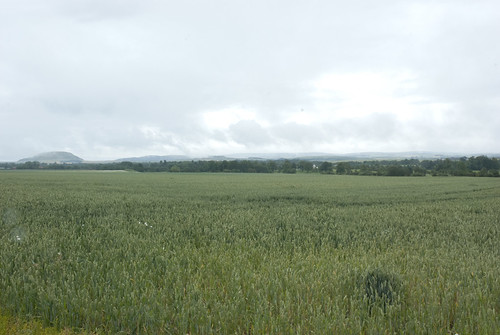
Cloud One - Hills Sunlight
I got on my return later in the day.
D80,Aperture f/22, Shutter Speed 1/125 sec, ISO 500, 24mm (35mm equivalent 36mm), Pattern Metering Mode, Daylight White Balance, Hand Held, 18-70mm lens
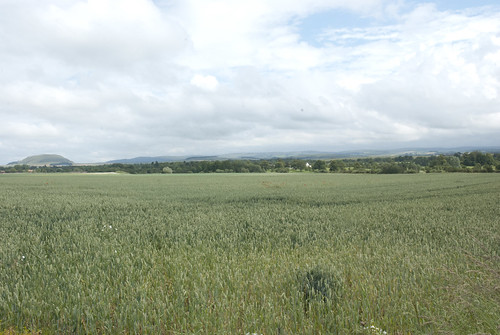
The first thing I noticed was that I had to bring the ISO down from 1000 to 500 to even attempt the same settings for speed and aperture on the camera. I could also only get the same aperture by increasing the speed; so there was a vast difference in the amount of light coming into the lens. I also noticed that the landscape looked brighter and less blue in the second image and in the second image these was more of a yellow hue to the light. I could also make out more detail as the clouds were not so low.
Clouds Two - Flowers Sunlight
Sitting at the edge of the field tucked in beside all the grass and weeds was a small blue/violet flower. The colour caught my eye and I noted its’ position and returned to photograph it later in the day.
D80,Aperture f/19, Shutter Speed 1/125 sec, ISO 500, 48mm (35mm equivalent 72mm), Pattern Metering Mode, Daylight White Balance, Hand Held, 18-70mm lens
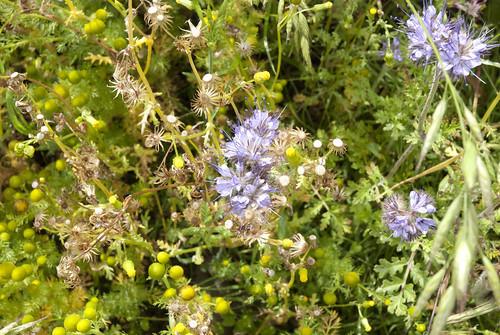
Clouds Two – Flowers Clouds
D80,Aperture f/13, Shutter Speed 1/125 sec, ISO 500, 48mm (35mm equivalent 72mm), Pattern Metering Mode, Daylight White Balance, Hand Held, 18-70mm lens
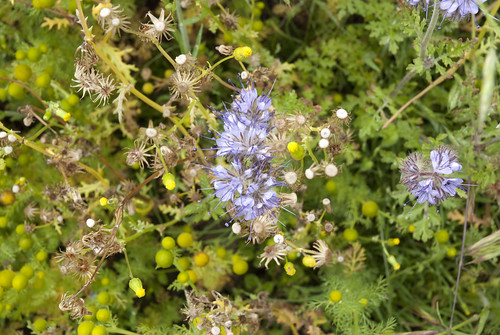
I was luckier here and managed to keep the same ISO and speed settings. I could see that there was a 3 f/stop difference between the two images and that the shadows were less well defined in the second image.
Clouds Three – Sunlight
D80,Aperture f/22, Shutter Speed 1/125 sec, ISO 500, 65mm (35mm equivalent 97mm), Pattern Metering Mode, Daylight White Balance, Hand Held, 18-70mm lens
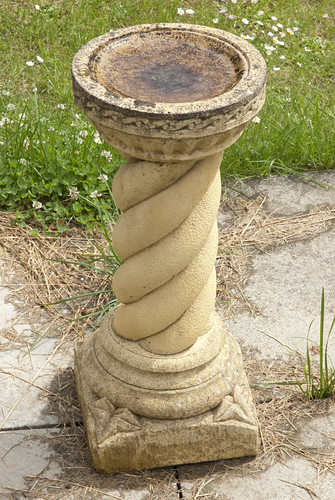
Clouds Three – Clouds
D80,Aperture f/13, Shutter Speed 1/125 sec, ISO 500, 65mm (35mm equivalent 97mm), Pattern Metering Mode, Daylight White Balance, Hand Held, 18-70mm lens
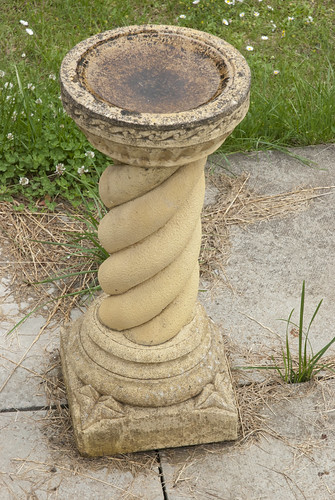
A difference of 4 f/stops. Here I could see a difference in the background colours as well as a loss of shadow from the birdbath. There is also a slight loss of detail and tonal range in the second image as the contrast between dark and light is not so great.
Exercise 35 Cloudy Weather and Rain – Part Two
What: The main brief of this exercise was to take three photographs of a subject outdoors where the day was overcast. To make the good use of the enveloping shapeless light.
Where: In a nearby park
When: Mid morning, just after a short rain shower, where the sky was grey and covered in low cloud.
How: I moved around the tree stump until I found a couple of locations on the subject where I could get photographs of the detail through the relief of the subject..
The first image I took was when I was setting out for the day to take the images for this exercise, I could see that it was about to rain and that in the distance the clouds were low and the day was overcast.
Overcast One
I noticed the green colour of the moss against the grey and brown of the tree stump. I moved close in to prevent any shadow being cast by nearby branches and photographed the texture and detail of the bark.
D80,Aperture f/8, Shutter Speed 1/30 sec, ISO 1600, 52mm (35mm equivalent 78mm), Pattern Metering Mode, Daylight White Balance, Hand Held, 18-70mm lens
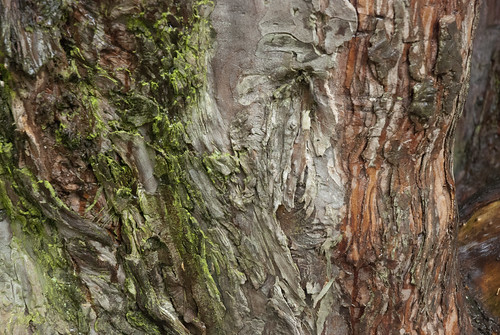
I really like the stark green of the moss against the trunk and I was surprised to see how much detail and relief came out of the bark even through the light was pretty much uniform. I like the breakup and shadow of the bark and the many different shaded and shapes that it makes.
Overcast Two
D80,Aperture f/8, Shutter Speed 1/15 sec, ISO 1600, 18mm (35mm equivalent 27mm), Pattern Metering Mode, Daylight White Balance, Hand Held, 18-70mm lens

As I moved around the stump I took a step back and noticed that uniformity of light and that in some places of the stump there were not colour differences due to the uniformity of the light. I did like however the fact that I could follow the lines and shapes of the bark and that the detail and texture of the bark were brought out by the light.
Overcast Three
Again moving around the tree, into a area which I had thought would have been in more shadow I picked out the green and brown of the stump again. I noted that there was little difference in the levels of light on either side of the stump and that even after the rain, the levels of light on the trunk allowed me to pick out the shape, the shadows and the texture of the bark.
D80,Aperture f/8, Shutter Speed 1/10 sec, ISO 1600, 18mm (35mm equivalent 27mm), Pattern Metering Mode, Daylight White Balance, Hand Held, 18-70mm lens
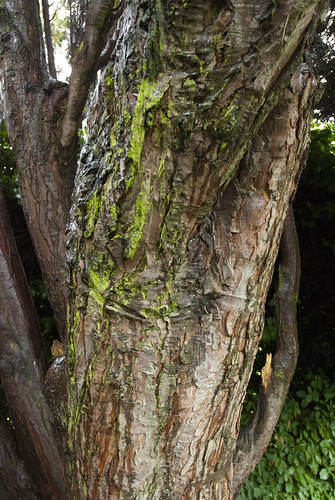
Exercise 35 Cloudy Weather and Rain – Part Three
What: The main brief of this exercise was to take a number of photographs outdoors where it was raining.
Where: In a nearby town and streets
When: Mid morning, when it was raining and where the sky was grey and covered in low cloud.
How: I moved around looking for good locations to photograph where I could see that the rain had brought additional effects to the location.
Rain One
D80,Aperture f/4, Shutter Speed 1/2000 sec, ISO 1000, 105mm (35mm equivalent 157mm), Pattern Metering Mode, Daylight White Balance, Hand Held, 105mm lens
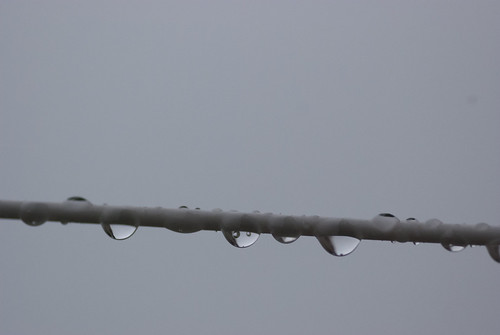
It had just started to rain and as I looked out a window I noted the water droplets gathering on a line. I went outside and with a macro lens look the image of the small droplets on the line after composing on the droplets which reflected both the sky and the house. While I like the composition on the droplets I am not too happy with the overall composition as the background is just a washed out underexposed grey detail less sky.
Rain Two
I went out and about heading for the middle of the town, as it is mainly covered in slabs and it had the most amounts of people passing through on a rainy day.
Lining up on the misaligned bollards I shot along the front of the local court house, getting the repetition of the buckets and planters along the pavement. I was looking to capture the reflections of the colours in the rain slicked pavements. I am very happy with this as I managed to get the browns, reds and greens reflected and the image shows what a damp day it was.
D80,Aperture f/8, Shutter Speed 1/500 sec, ISO 1000, 34mm (35mm equivalent 51mm), Pattern Metering Mode, Daylight White Balance, Hand Held, 18-70mm lens
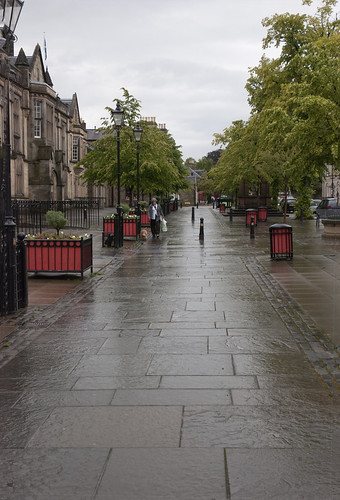
Rain Three
As I travelled back to the car, I was looking around me for more examples of the rain and wet weather; I looked up and noticed the droplets hanging off the leaf. I quickly shot a bracketed set of images as I was not sure how the light was going to affect the final image due to the light travelling though the branches, the leaves above and the fact that I was using a telephoto lens.
D50,Aperture f/5.6, Shutter Speed 1/180 sec, +0.5, ISO 200, 112mm (35mm equivalent 169mm), Pattern Metering Mode, Daylight White Balance, Hand Held, 55-200mm lens
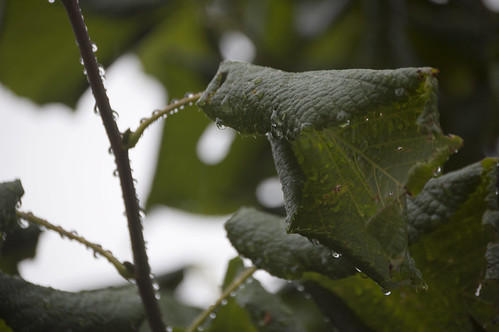
I learned a lot from this exercise.
1. There is a huge difference in the amount of light between a bright day and a cloud day. This will have an effect on not only the shutter speed and aperture choice, but it will have a effect on the colour of the light and on the depth of the shadows in the image.
2. That overcast days can be used to bring out the detail in a subject through the use of the uniform light. Look for detail and texture within the subject and take advantage of the flat light to bring out the shade and depth of the subject through the use of texture and relief.
3. Rain should not mean that you cannot photograph. I was surprised to see that the rain brought out a lot of colour, shape and shadow in things which would normally be uniform and blank. Buildings, paths and the sky can all be photographed during the rain as in a lot of cases the rain adds colour, shade, relief and shape to objects.
No comments:
Post a Comment